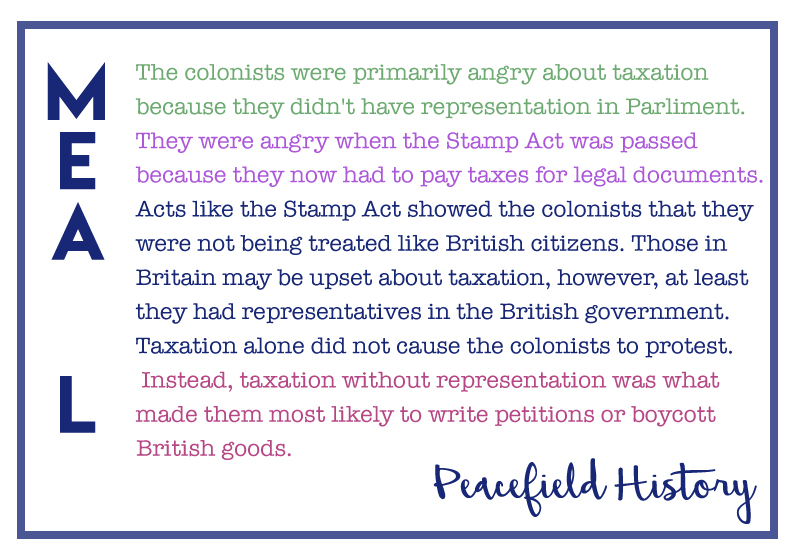
In recent years, I’ve noticed that Social Studies teachers are incorporating more writing into their classrooms. This makes my teacher heart happy, as I know that writing is absolutely crucial for students to understand and think critically about history. Obviously, when teaching students to write, teachers develop strategies to make sure that student writing is sophisticated. One of the most common acronyms used among teachers is RACE.
I understand why RACE is popular. Many English teachers are utilizing RACE, so it’s easy for Social Studies teachers to carry the RACE acronym on over to Social Studies. However, RACE doesn’t fit Social Studies curriculum very well at all. Therefore, I’ve adopted a different acronym for my classes – MEAL. I thought I would break this down with a comparison for each letter, so that you can see why MEAL makes a much better fit.
Restate
Here students are typically re-wording the question into a full sentence. I understand this approach, as it makes for an easy introduction for students.
Instead, use “Main Idea.”
With this, I have students give me the point they will argue with their paragraph. With a single paragraph response, I typically ask students a question I want them to answer. They know to start their paragraph with a general response to that question that represented the main point they will argue, not just a rewording. For example:
Question – Why were colonists angry about taxation?
Main Idea – The colonists were primarily angry about taxation because they didn’t have representation in Parliment.
Answer
I don’t need students to do this, as they already did so with their first sentence.
Cite
With this students typically provide quotes from the text to support an answer they have given. I find this to be unnecessary. In upper-level History classes, students are typically discouraged from quoting. Therefore, I don’t want to start them out this way. Secondly, quoting in Social Studies doesn’t really add to the writing in Social Studies. Having students quote the definition for a particular act doesn’t tell me that they understand what that act really meant. (Students can still use quotes if they fit, however, it doesn’t pigeonhole them into doing so.)
Instead, use “Evidence.”
With evidence, I tell students to explain a historical event in their own words to support the main idea. I love this alternative because it can work for all levels of writing and naturally differentiates. For example:
Version 1 – They were angry when the Stamp Act was passed because they now had to pay taxes for legal documents. (Middle School)
Version 2 – Colonial leaders, like Ben Franklin, had drawn a line between virtual and actual representation. Although Parliment had argued that they had representation by being part of the British Empire, the colonists wanted actual leaders representing them in Parliment. Therefore, when the Stamp Act, an internal tax, was passed, some colonists were outraged. (Advanced High School)
See? In each of these versions, students are showing evidence of thought. This is a much better approach than having them simply quote the Stamp Act.
Explain
Explain is very similar to Analyze. However, I’d argue that analyze is more explicit in expectation. I tell students that I want to see how the evidence is connected to the main idea. Again, the analysis also allows for natural differentiation. For example:
“Analyze”
Acts like the Stamp Act showed the colonists that they were not being treated like British citizens. Those in Britain may be upset about taxation, however, at least they had representatives in the British government.
“Link”
Finally, my students end their paragraphs with a link back to the main idea. This reinforces the point they were making with their first sentence. For example:
Taxation alone did not cause the colonists to protest. Instead, taxation without representation was what made them most likely to write petitions or boycott British goods.
MEAL for Paragraph Writing
If you put it all together, it reads like this:
I can use MEAL for individual paragraphs, and for the body paragraphs of an essay. I have students write this way in 7th grade and in AP. I’ve noticed much more detailed and thoughtful paragraphs since I’ve implemented MEAL.
Have you considered changing your writing acronym for extended response questions?


14 Responses
I love this idea! When answering a question that forces students to use evidence from 3 or more sources, what would you suggest when using this format?
In that case, I suggest dividing the answer into multiple paragraphs, more like a DBQ essay. You can still use the same process with multiple body paragraphs.
I LOVE this idea! I am assigning my US History class (academic) an essay this week. I have found that I need to start from scratch as many students do not have experience with essay writing. I have 2 questions- do you have the MEAL image sold in TPT to be printed as a poster? And do you have a basic essay rubric you use-similar to your One Pager? -From an Econ teacher trying to teach US and World (totally out of my element!)
Trying this out today with my 7th graders. I did also notice Parliament misspelled above. 🙂
Glad to hear. Yep, I’m human. I make mistakes.
What about supporting details for your paragraph? There are supposed to be three supporting details for each the topic sentence.
Should I place supporting details in the evidence or analysis?
? I’m confused by your question. The E and A are the supporting details.
Thanks for responding to the question: an essay has three paragraphs (the body) of the essay. In the each paragraph in the body of the essay, I have to make a claim about my topic; this is followed by supporting sentence or details.
But this style is an interesting style: main idea, evidence, analysis and link. The question I am asking is do I have one point for each paragraph in this style. You made me think about the question. This is not a jest.
Second question: what are some questions to ask when making an analysis about the evidence?
Any question that requires the students to think about the evidence presented. It really depends on the topic!
Hi! I’ve been teaching this format for many years across many subject areas, and it lends itself quite nicely to multi-paragraph writing. If my students are writing a 5-paragraph essay, for example, each main idea or topic sentence should be pulled directly from their thesis statement. I also let kids know that they can have a really big meal with multiple pieces of evidence and analysis. The last thought should transition to the next paragraph.
Finally, I teach my students that the analysis should illustrate HOW the evidence supports the main idea. As the reader, why is it important to understand this evidence to understand the larger main idea?
Hope this help!
Great idea! I love this. I will be using this on my 7th grade Social Studies class. I want them to expand their ability to answer short answer questions.
Thanks again.
P.S. I can see this technique used in all subjects including explaining how students got an answer to a mathematical problem or for a Biology/Chemistry/Physics question.
Oh agreed!
I started using MEAL after I learned about this method in graduate school. It’s easily adapted to middle and high school, and I find that their writing is so much more precise. My sister is an elementary school teacher and still uses RACE. I’ve tried to convert her!
Oh believe me I have tried also. It takes some convincing!